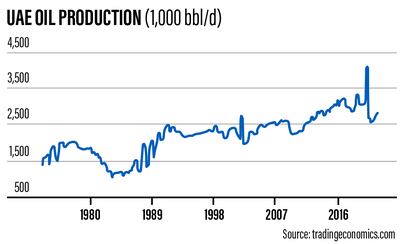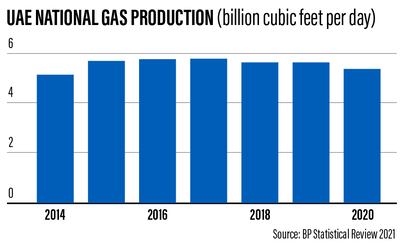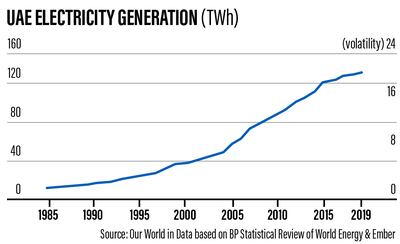The UAE has come a long way from the time the first oil well was struck and crude became the country's most important commodity, bringing wealth and prosperity to its people.
Now, 50 years on, the country is looking ahead to the next half a century, where hydrocarbons will no longer be the mainstay of the world economy.
The UAE is innovating along with other regional and global producers to diversify its assets, improve efficiency, turn to renewables as an alternative source and grow into a world leader in developing hydrogen.
Oil and gas, however, remain critical to the development of the country, with Abu Dhabi National Oil Company, the state energy giant, continuing to invest in developing hydrocarbon resources.
The UAE accounts for about 4 per cent of global oil production, with the bulk of the output from fields owned and managed by Adnoc. The country is also on track to raise its overall capacity of production to 5 million barrels per day by 2030.
The emirates, which generates power from gas is also substantially increasing the volumes of the fuel, which is lower carbon to meet its growing consumption requirements.
The UAE, Opec's third-largest producer, consumes around 7.4 billion cubic feet (bcf/d) of gas per day largely to meet power demand, with the total share of imported fuel at 30 per cent, energy consultancy FGE estimates.
Abu Dhabi is prioritising the development of gas from unconventional reserves, which are deposits that were earlier considered commercially unviable to exploit.
The UAE announced the discovery of additional reserves of 7 billion “stock tank” barrels of oil, 58 trillion cf of conventional gas and 160tcf of unconventional gas in 2019.
This pushed the country up the rankings in terms of hydrocarbon reserves, data from the US Energy Information Administration showed.
Last year, the UAE also announced the discovery of 80tcf of shallow gas reserves in an area between Abu Dhabi and Dubai — the biggest discovery in 15 years.
Adnoc has also advanced more efficient production of oil and gas over the past five years, deploying big data and artificial intelligence to produce hydrocarbons more efficiently.
In February, Adnoc said it generated $1.1 billion in business value through the deployment of Big Data and analytics at its Thamama Centre, which oversees upstream operations. The company accrued $2bn in cost savings over the past five years by employing advanced technology and digitalisation to optimise its drilling operations.
The Thamama centre, which is named after the most dominant reservoir formation in Abu Dhabi, is part of the company's continuing investments in advanced technology, digitalisation and artificial intelligence, in order to drive greater efficiencies.
Adnoc has also formed a joint venture known as AIQ with Abu Dhabi artificial intelligence firm Group 42 to develop and commercialise AI products and applications for the oil and gas industry.
AIQ, Group 42 and the world's largest energy services firm, Schlumberger, also have an agreement to develop and sell AI products for the global exploration and production market.
The UAE also plans to find additional uses for crude to meet the growing global demand for chemicals, as well as to create a manufacturing hub in the country. The country plans to triple petrochemical production capacity from 4.5 million tonnes — currently produced entirely by the Borouge facility in Ruwais — by 2025.
Adnoc is also an early starter among regional energy companies in terms of opening up assets to foreign investment.
Even in the midst of the pandemic, Adnoc helped attract Dh62bn ($16.8bn) in foreign direct investment to the UAE this year, mainly through various multibillion dollar transactions signed in the midstream and infrastructure segments.
Between 2016 and 2020, the state-owned firm helped drive Dh237bn in FDI flows to the UAE.
At the height of the pandemic, a consortium of the world’s leading infrastructure and sovereign wealth funds signed an agreement worth $20.7bn to invest in Abu Dhabi’s natural gas pipelines infrastructure. The transaction, the largest single global energy infrastructure deal at the time and the Middle East's biggest, will unlock $10.1bn of foreign investment into the UAE.
Global Infrastructure Partners, Brookfield Asset Management, Singapore’s sovereign wealth fund GIC, Ontario Teachers’ Pension Plan Board, South Korea's NH Investment & Securities and Italy’s Snam took stakes in Adnoc’s lucrative midstream assets.
Adnoc also entered into a $5.5bn deal with Apollo Global Management to lease some of its properties, which led to a further FDI inflow of $2.7bn.
The UAE has continuously tried to position itself ahead of the curve and in many respects is a bellwether of changing regional market dynamics. It has embraced the energy transition by taking a leading position in new fuels such as green and blue hydrogen as it looks to tap the growing market for low-carbon fuel.
Following the latest edition of Abu Dhabi International Petroleum Exhibition and Conference, by The National's estimate, the week-long event resulted in more than $13.7bn of investment pledged to develop the UAE's upstream and downstream sectors. The figure takes into account only planned investments and awards by Adnoc, and does not include preliminary agreements by other companies.
The UAE in line with the global efforts to transition away from fossil fuels will also now host the 28th Conference of Parties in 2023 following its pledge this year to reach net zero by the middle of the century.
The country created history by becoming the first Arab nation to pledge to offset all carbon emissions it creates domestically ahead of Cop26.
As the country looks forward to a new age away from oil, Adnoc is also adding renewables to its portfolio.
Along with Taqa, a major player in utilities, Adnoc will form a joint venture to invest in renewables.
The companies joined forces to create a global renewable energy and green hydrogen venture that will have a generating capacity of 30 gigawatts by 2030.
The two companies will partner on domestic and international renewable energy and waste-to-energy projects, as well as the production, processing, and storage of green hydrogen.
MATCH INFO
Inter Milan v Juventus
Saturday, 10.45pm (UAE)
Watch the match on BeIN Sports
Trump v Khan
2016: Feud begins after Khan criticised Trump’s proposed Muslim travel ban to US
2017: Trump criticises Khan’s ‘no reason to be alarmed’ response to London Bridge terror attacks
2019: Trump calls Khan a “stone cold loser” before first state visit
2019: Trump tweets about “Khan’s Londonistan”, calling him “a national disgrace”
2022: Khan’s office attributes rise in Islamophobic abuse against the major to hostility stoked during Trump’s presidency
July 2025 During a golfing trip to Scotland, Trump calls Khan “a nasty person”
Sept 2025 Trump blames Khan for London’s “stabbings and the dirt and the filth”.
Dec 2025 Trump suggests migrants got Khan elected, calls him a “horrible, vicious, disgusting mayor”
COMPANY%20PROFILE
%3Cp%3E%3Cstrong%3EName%3A%3C%2Fstrong%3E%20Carzaty%2C%20now%20Kavak%3Cbr%3E%3Cstrong%3EBased%3A%3C%2Fstrong%3E%20Dubai%3Cbr%3E%3Cstrong%3ELaunch%20year%3A%20%3C%2Fstrong%3ECarzaty%20launched%20in%202018%2C%20Kavak%20in%20the%20GCC%20launched%20in%202022%3Cbr%3E%3Cstrong%3ENumber%20of%20employees%3A%3C%2Fstrong%3E%20140%3Cbr%3E%3Cstrong%3ESector%3A%3C%2Fstrong%3E%20Automotive%3Cbr%3E%3Cstrong%3EFunding%3A%20%3C%2Fstrong%3ECarzaty%20raised%20%246m%20in%20equity%20and%20%244m%20in%20debt%3B%20Kavak%20plans%20%24130m%20investment%20in%20the%20GCC%3C%2Fp%3E%0A
WHAT%20IS%20THE%20LICENSING%20PROCESS%20FOR%20VARA%3F
%3Cp%3EVara%20will%20cater%20to%20three%20categories%20of%20companies%20in%20Dubai%20(except%20the%20DIFC)%3A%3C%2Fp%3E%0A%3Cp%3E%3Cstrong%3ECategory%20A%3A%3C%2Fstrong%3E%20Minimum%20viable%20product%20(MVP)%20applicants%20that%20are%20currently%20in%20the%20process%20of%20securing%20an%20MVP%20licence%3A%20This%20is%20a%20three-stage%20process%20starting%20with%20%5B1%5D%20a%20provisional%20permit%2C%20graduating%20to%20%5B2%5D%20preparatory%20licence%20and%20concluding%20with%20%5B3%5D%20operational%20licence.%20Applicants%20that%20are%20already%20in%20the%20MVP%20process%20will%20be%20advised%20by%20Vara%20to%20either%20continue%20within%20the%20MVP%20framework%20or%20be%20transitioned%20to%20the%20full%20market%20product%20licensing%20process.%3C%2Fp%3E%0A%3Cp%3E%3Cstrong%3ECategory%20B%3A%3C%2Fstrong%3E%20Existing%20legacy%20virtual%20asset%20service%20providers%20prior%20to%20February%207%2C%202023%2C%20which%20are%20required%20to%20come%20under%20Vara%20supervision.%20All%20operating%20service%20proviers%20in%20Dubai%20(excluding%20the%20DIFC)%20fall%20under%20Vara%E2%80%99s%20supervision.%3C%2Fp%3E%0A%3Cp%3E%3Cstrong%3ECategory%20C%3A%3C%2Fstrong%3E%20New%20applicants%20seeking%20a%20Vara%20licence%20or%20existing%20applicants%20adding%20new%20activities.%20All%20applicants%20that%20do%20not%20fall%20under%20Category%20A%20or%20B%20can%20begin%20the%20application%20process%20through%20their%20current%20or%20prospective%20commercial%20licensor%20%E2%80%94%20the%20DET%20or%20Free%20Zone%20Authority%20%E2%80%94%20or%20directly%20through%20Vara%20in%20the%20instance%20that%20they%20have%20yet%20to%20determine%20the%20commercial%20operating%20zone%20in%20Dubai.%C2%A0%3C%2Fp%3E%0A
The%20specs
%3Cp%3E%3Cstrong%3EEngine%3A%20%3C%2Fstrong%3E6.5-litre%20V12%3Cbr%3E%3Cstrong%3EPower%3A%20%3C%2Fstrong%3E725hp%20at%207%2C750rpm%3Cbr%3E%3Cstrong%3ETorque%3A%20%3C%2Fstrong%3E716Nm%20at%206%2C250rpm%3Cbr%3E%3Cstrong%3ETransmission%3A%20%3C%2Fstrong%3E8-speed%20dual-clutch%20auto%3Cbr%3E%3Cstrong%3EOn%20sale%3A%20%3C%2Fstrong%3EQ4%202023%3Cbr%3E%3Cstrong%3EPrice%3A%20%3C%2Fstrong%3EFrom%20Dh1%2C650%2C000%3C%2Fp%3E%0A
Mercer, the investment consulting arm of US services company Marsh & McLennan, expects its wealth division to at least double its assets under management (AUM) in the Middle East as wealth in the region continues to grow despite economic headwinds, a company official said.
Mercer Wealth, which globally has $160 billion in AUM, plans to boost its AUM in the region to $2-$3bn in the next 2-3 years from the present $1bn, said Yasir AbuShaban, a Dubai-based principal with Mercer Wealth.
“Within the next two to three years, we are looking at reaching $2 to $3 billion as a conservative estimate and we do see an opportunity to do so,” said Mr AbuShaban.
Mercer does not directly make investments, but allocates clients’ money they have discretion to, to professional asset managers. They also provide advice to clients.
“We have buying power. We can negotiate on their (client’s) behalf with asset managers to provide them lower fees than they otherwise would have to get on their own,” he added.
Mercer Wealth’s clients include sovereign wealth funds, family offices, and insurance companies among others.
From its office in Dubai, Mercer also looks after Africa, India and Turkey, where they also see opportunity for growth.
Wealth creation in Middle East and Africa (MEA) grew 8.5 per cent to $8.1 trillion last year from $7.5tn in 2015, higher than last year’s global average of 6 per cent and the second-highest growth in a region after Asia-Pacific which grew 9.9 per cent, according to consultancy Boston Consulting Group (BCG). In the region, where wealth grew just 1.9 per cent in 2015 compared with 2014, a pickup in oil prices has helped in wealth generation.
BCG is forecasting MEA wealth will rise to $12tn by 2021, growing at an annual average of 8 per cent.
Drivers of wealth generation in the region will be split evenly between new wealth creation and growth of performance of existing assets, according to BCG.
Another general trend in the region is clients’ looking for a comprehensive approach to investing, according to Mr AbuShaban.
“Institutional investors or some of the families are seeing a slowdown in the available capital they have to invest and in that sense they are looking at optimizing the way they manage their portfolios and making sure they are not investing haphazardly and different parts of their investment are working together,” said Mr AbuShaban.
Some clients also have a higher appetite for risk, given the low interest-rate environment that does not provide enough yield for some institutional investors. These clients are keen to invest in illiquid assets, such as private equity and infrastructure.
“What we have seen is a desire for higher returns in what has been a low-return environment specifically in various fixed income or bonds,” he said.
“In this environment, we have seen a de facto increase in the risk that clients are taking in things like illiquid investments, private equity investments, infrastructure and private debt, those kind of investments were higher illiquidity results in incrementally higher returns.”
The Abu Dhabi Investment Authority, one of the largest sovereign wealth funds, said in its 2016 report that has gradually increased its exposure in direct private equity and private credit transactions, mainly in Asian markets and especially in China and India. The authority’s private equity department focused on structured equities owing to “their defensive characteristics.”
The specs
Engine: 4.0-litre V8 twin-turbocharged and three electric motors
Power: Combined output 920hp
Torque: 730Nm at 4,000-7,000rpm
Transmission: 8-speed dual-clutch automatic
Fuel consumption: 11.2L/100km
On sale: Now, deliveries expected later in 2025
Price: expected to start at Dh1,432,000
Company Profile
Founder: Omar Onsi
Launched: 2018
Employees: 35
Financing stage: Seed round ($12 million)
Investors: B&Y, Phoenician Funds, M1 Group, Shorooq Partners
The five pillars of Islam
1. Fasting
2. Prayer
3. Hajj
4. Shahada
5. Zakat
Indoor cricket in a nutshell
Indoor Cricket World Cup - Sept 16-20, Insportz, Dubai
16 Indoor cricket matches are 16 overs per side
8 There are eight players per team
9 There have been nine Indoor Cricket World Cups for men. Australia have won every one.
5 Five runs are deducted from the score when a wickets falls
4 Batsmen bat in pairs, facing four overs per partnership
Scoring In indoor cricket, runs are scored by way of both physical and bonus runs. Physical runs are scored by both batsmen completing a run from one crease to the other. Bonus runs are scored when the ball hits a net in different zones, but only when at least one physical run is score.
Zones
A Front net, behind the striker and wicketkeeper: 0 runs
B Side nets, between the striker and halfway down the pitch: 1 run
C Side nets between halfway and the bowlers end: 2 runs
D Back net: 4 runs on the bounce, 6 runs on the full
Racecard
6.30pm: The Madjani Stakes (PA) Group 3 Dh175,000 (Dirt) 1,900m
7.05pm: Maiden (TB) Dh165,000 (D) 1,400m
7.40pm: Maiden (TB) Dh165,000 (D) 1,600m
8.15pm: Handicap (TB) Dh190,000 (D) 1,200m
8.50pm: Dubai Creek Mile (TB) Listed Dh265,000 (D) 1,600m
9.25pm: Handicap (TB) Dh190,000 (D) 1,600m
The National selections
6.30pm: Chaddad
7.05pm: Down On Da Bayou
7.40pm: Mass Media
8.15pm: Rafal
8.50pm: Yulong Warrior
9.25pm: Chiefdom
Mohammed bin Zayed Majlis
Classification of skills
A worker is categorised as skilled by the MOHRE based on nine levels given in the International Standard Classification of Occupations (ISCO) issued by the International Labour Organisation.
A skilled worker would be someone at a professional level (levels 1 – 5) which includes managers, professionals, technicians and associate professionals, clerical support workers, and service and sales workers.
The worker must also have an attested educational certificate higher than secondary or an equivalent certification, and earn a monthly salary of at least Dh4,000.
Desert Warrior
Starring: Anthony Mackie, Aiysha Hart, Ben Kingsley
Director: Rupert Wyatt
Rating: 3/5
UK’s AI plan
- AI ambassadors such as MIT economist Simon Johnson, Monzo cofounder Tom Blomfield and Google DeepMind’s Raia Hadsell
- £10bn AI growth zone in South Wales to create 5,000 jobs
- £100m of government support for startups building AI hardware products
- £250m to train new AI models
Wicked: For Good
Director: Jon M Chu
Starring: Ariana Grande, Cynthia Erivo, Jonathan Bailey, Jeff Goldblum, Michelle Yeoh, Ethan Slater
Rating: 4/5
Killing of Qassem Suleimani
Past winners of the Abu Dhabi Grand Prix
2016 Lewis Hamilton (Mercedes-GP)
2015 Nico Rosberg (Mercedes-GP)
2014 Lewis Hamilton (Mercedes-GP)
2013 Sebastian Vettel (Red Bull Racing)
2012 Kimi Raikkonen (Lotus)
2011 Lewis Hamilton (McLaren)
2010 Sebastian Vettel (Red Bull Racing)
2009 Sebastian Vettel (Red Bull Racing)
Who's who in Yemen conflict
Houthis: Iran-backed rebels who occupy Sanaa and run unrecognised government
Yemeni government: Exiled government in Aden led by eight-member Presidential Leadership Council
Southern Transitional Council: Faction in Yemeni government that seeks autonomy for the south
Habrish 'rebels': Tribal-backed forces feuding with STC over control of oil in government territory
Like a Fading Shadow
Antonio Muñoz Molina
Translated from the Spanish by Camilo A. Ramirez
Tuskar Rock Press (pp. 310)
How to report a beggar
Abu Dhabi – Call 999 or 8002626 (Aman Service)
Dubai – Call 800243
Sharjah – Call 065632222
Ras Al Khaimah - Call 072053372
Ajman – Call 067401616
Umm Al Quwain – Call 999
Fujairah - Call 092051100 or 092224411
Dr Afridi's warning signs of digital addiction
Spending an excessive amount of time on the phone.
Neglecting personal, social, or academic responsibilities.
Losing interest in other activities or hobbies that were once enjoyed.
Having withdrawal symptoms like feeling anxious, restless, or upset when the technology is not available.
Experiencing sleep disturbances or changes in sleep patterns.
What are the guidelines?
Under 18 months: Avoid screen time altogether, except for video chatting with family.
Aged 18-24 months: If screens are introduced, it should be high-quality content watched with a caregiver to help the child understand what they are seeing.
Aged 2-5 years: Limit to one-hour per day of high-quality programming, with co-viewing whenever possible.
Aged 6-12 years: Set consistent limits on screen time to ensure it does not interfere with sleep, physical activity, or social interactions.
Teenagers: Encourage a balanced approach – screens should not replace sleep, exercise, or face-to-face socialisation.
Source: American Paediatric Association
Tamkeen's offering
- Option 1: 70% in year 1, 50% in year 2, 30% in year 3
- Option 2: 50% across three years
- Option 3: 30% across five years
THE BIO
Ms Al Ameri likes the variety of her job, and the daily environmental challenges she is presented with.
Regular contact with wildlife is the most appealing part of her role at the Environment Agency Abu Dhabi.
She loves to explore new destinations and lives by her motto of being a voice in the world, and not an echo.
She is the youngest of three children, and has a brother and sister.
Her favourite book, Moby Dick by Herman Melville helped inspire her towards a career exploring the natural world.
Results:
5pm: Handicap (PA) | Dh80,000 | 1,600 metres
Winner: Dasan Da, Saeed Al Mazrooei (jockey), Helal Al Alawi (trainer)
5.30pm: Maiden (PA) | Dh80,000 | 1,600m
Winner: AF Saabah, Tadhg O’Shea, Ernst Oertel
6pm: Handicap (PA) | Dh80,000 | 1,600m
Winner: Mukaram, Pat Cosgrave, Eric Lemartinel
6.30pm: Handicap (PA) | Dh80,000 | 2,200m
Winner: MH Tawag, Richard Mullen, Elise Jeanne
7pm: Wathba Stallions Cup Handicap (PA) | Dh70,000 | 1,400m
Winner: RB Inferno, Fabrice Veron, Ismail Mohammed
7.30pm: Handicap (TB) | Dh100,000 | 1,600m
Winner: Juthoor, Jim Crowley, Erwan Charpy
How%20champions%20are%20made
%3Cp%3E%0D%3Cstrong%3EDiet%3C%2Fstrong%3E%20%0D%3Cbr%3E7am%20-%20Protein%20shake%20with%20oats%20and%20fruits%0D%3Cbr%3E10am%20-%205-6%20egg%20whites%0D%3Cbr%3E1pm%20-%20White%20rice%20or%20chapati%20(Indian%20bread)%20with%20chicken%0D%3Cbr%3E4pm%20-%20Dry%20fruits%20%0D%3Cbr%3E7.30pm%20-%20Pre%20workout%20meal%20%E2%80%93%20grilled%20fish%20or%20chicken%20with%20veggies%20and%20fruits%0D%3Cbr%3E8.30pm%20to%20midnight%20workout%0D%3Cbr%3E12.30am%20%E2%80%93%20Protein%20shake%20%0D%3Cbr%3E%3Cstrong%3ETotal%20intake%3A%3C%2Fstrong%3E%204000-4500%20calories%20%0D%3Cbr%3E%3Cstrong%3ESaidu%E2%80%99s%20weight%3A%3C%2Fstrong%3E%20110%20kg%0D%3Cbr%3E%3Cstrong%3EStats%3A%3C%2Fstrong%3E%20Biceps%2019%20inches.%20Forearms%2018%20inches%3C%2Fp%3E%0A
The specs: 2018 Range Rover Velar R-Dynamic HSE
Price, base / as tested: Dh263,235 / Dh420,000
Engine: 3.0-litre supercharged V6
Power 375hp @ 6,500rpm
Torque: 450Nm @ 3,500rpm
Transmission: Eight-speed automatic
Fuel consumption, combined: 9.4L / 100kms
Lexus LX700h specs
Engine: 3.4-litre twin-turbo V6 plus supplementary electric motor
Power: 464hp at 5,200rpm
Torque: 790Nm from 2,000-3,600rpm
Transmission: 10-speed auto
Fuel consumption: 11.7L/100km
On sale: Now
Price: From Dh590,000
The%20specs
%3Cp%3E%3Cstrong%3EPowertrain%3A%20%3C%2Fstrong%3ESingle%20electric%20motor%0D%3Cbr%3E%3Cstrong%3EPower%3A%20%3C%2Fstrong%3E201hp%0D%3Cbr%3E%3Cstrong%3ETorque%3A%20%3C%2Fstrong%3E310Nm%0D%3Cbr%3E%3Cstrong%3ETransmission%3A%20%3C%2Fstrong%3ESingle-speed%20auto%0D%3Cbr%3E%3Cstrong%3EBattery%3A%20%3C%2Fstrong%3E53kWh%20lithium-ion%20battery%20pack%20(GS%20base%20model)%3B%2070kWh%20battery%20pack%20(GF)%0D%3Cbr%3E%3Cstrong%3ETouring%20range%3A%20%3C%2Fstrong%3E350km%20(GS)%3B%20480km%20(GF)%0D%3Cbr%3E%3Cstrong%3EPrice%3A%20%3C%2Fstrong%3EFrom%20Dh129%2C900%20(GS)%3B%20Dh149%2C000%20(GF)%0D%3Cbr%3E%3Cstrong%3EOn%20sale%3A%3C%2Fstrong%3E%20Now%3C%2Fp%3E%0A





